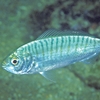General Description
Head large, bony, border of snout almost smooth; scales small, those along the lateral line large and bony. Red to brown above, with a black spot on the dorsal fin; inner surface of fan-like pectoral fins dark green above with a blue margin and an irregular black marking on the lower rear of fin. To 20 cm.
Biology
Taken as bycatch in commercial fisheries.
Habitat
Shelly and sandy bottoms in bays and along the coast, juveniles sometimes in seagrass beds, in depths of 2-110 m, although usually above 50 m.
Soft substrates
Seagrass meadows
Distribution guide
Southern Australia.
Species Group
Depth
Shallow (1-30 m)
Deep ( > 30 m)
Water Column
Max Size
20 cm
Diet
Carnivore
Commercial Species
No
Global Dispersal
Native to Australia
Conservation Status
- DSE Advisory List : Not listed
- EPBC Act 1999 : Not listed
- IUCN Red List : Not listed








